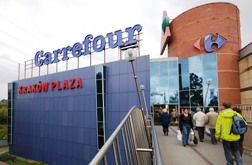Carrefour, the world’s second largest retailer after Wal-Mart, announced that it is launching a convenience store concept in Poland under a banner that translates as “5 Minutes.”
Poland itself is a substantial market and so this could turn into a lucrative addition to Carrefour’s already substantial operations there. Just last month Carrefour announced the opening of its 51st hypermarket in Poland.
More directly relevant, though, is that this seems part of a worldwide trend. We’ve chronicled this many times before, including our piece, Small Store Concepts Not Solely A Tesco Idea — Check Out Wellcome’s Express Fresh Model, which was built around Wellcome’s “Express Fresh” banner in Taiwan. Although Kroger does own a convenience store chain, the idea is best represented in the U.S. by Tesco’s imminent opening of its Fresh & Easy Neighborhood Market concept.

Opening of the 51st Carrefour Hypermarket in Cracow — On September 12th, 2007, Carrefour Poland inaugurated a new retail outlet in Cracow. This outlet is Carrefour’s 51st hypermarket in Poland with 2,200 sq.m of sales area.
What is driving this move to small store formats? Five things:
- Political difficulty securing sites for large stores. In many parts of certain countries, anyone who proposes a supercenter size store is guaranteed a lawsuit and, at very least, substantial delays in opening.
- The lack of availability of large sites in most urban areas. Even if the politics were friendly, there are just not many sites available in the inner suburbs and cities.
- High gas prices are causing consumer resistance to the long trip required to go to a more distant, larger store that draws from a larger radius.
- As fresh foods have become more important, more consumers need to fill in more frequently. This makes going to larger stores that are further away untenable.
- The “green” movement is leading at least some people to want to walk or bicycle to a neighborhood store.
Yet, most conventional supermarkets only draw people from a couple of miles, so how much closer can these smaller markets really be? Especially in our suburbs, where zoning typically separates commercial and residential property, so that the only “strips” where a store can be are on a main road?
Much depends on the degree to which consumers will, in fact, be satisfied with much smaller assortments. As Kroger’s CEO has pointed out, a small store isn’t convenient if it means you have to do a second trip.
There is a lot of indication, though, that many products in conventional supermarkets barely move at all. What we don’t know is how much people value variety and assortment, as a value in and of itself, as opposed to merely having the product they wind up buying.
In other words, not that many people buy red convertible sports cars, but having them in the window does seem to sell a lot of sedans and minivans.






